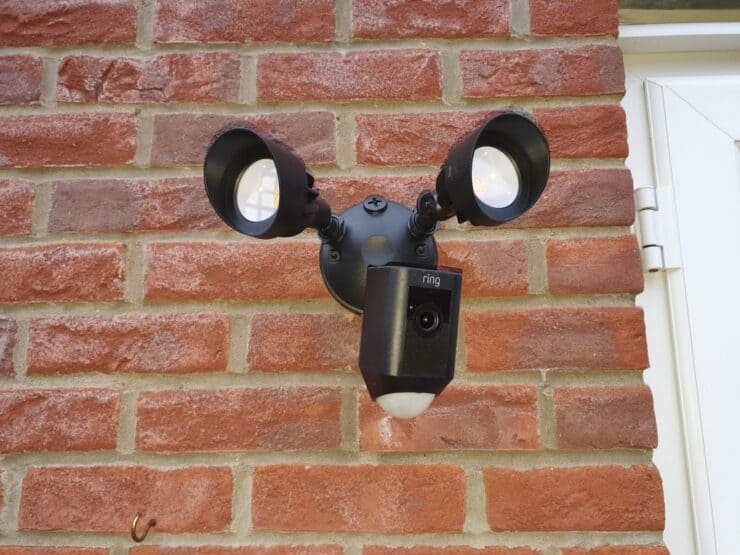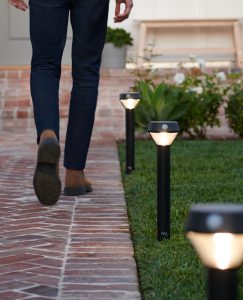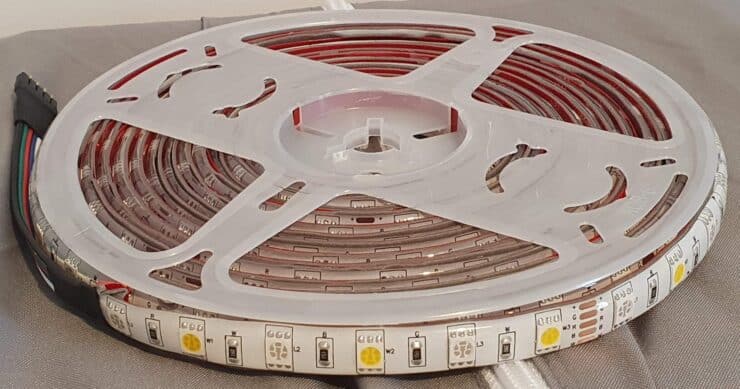Which Ring devices do you have around the house? Between their outdoor cameras and their new line of smart lights, Ring relies heavily on LEDs to make sure their devices are working properly. However, how long can we expect these LEDs to last?
Ring tech can get expensive. This is even more true when you’ve outfitted your whole house with their tech. When you buy new smart tech for the home, you want to make sure that the LED Ring lights are going to last.
Ring’s LEDs have a few different expected lifespans. Their cameras and floodlights are rated for 10-20 years of realistic use, while their new smart lights are expected to last for over 20,000 hours. However their ‘real world’ lifespan might be lower.
What is Ring?
Whether you’re just getting into smart home tech and DIY home security projects or you’ve been with us since the beginning, you’ve probably heard the name Ring.
After Ring was purchased by Amazon, they instantly shot up to being the single largest smart home tech grouping out there. Ring makes everything from home security products to their new line of Ring smart lighting. Ring products are designed to work seamlessly with Amazon’s Alexa which only goes to further bolster how popular this tech is on the market today.
Like pretty much every other smart home tech company, Ring lights relies on LED light for many of their devices. Here’s what you need to know about how long do ring led lights last.
Ring Floodlight Cam and Ring Spotlight Cam

The LED Ring light that power the Ring Floodlight Cam and the Ring Spotlight Cam are going to last a very long time, depending on how we look at the numbers.
These LED light are rated for tens of thousands of hours of operation. Now, there are just over 8,000 hours in a year so this might not sound like that much when you do the math. However, once we consider how these devices are used, it becomes clear that those tens of thousands of hours will be lasting us a very long time.
After all, these cams won’t be using their LEDs 24/7. In fact, you’re probably only going to have them on for a few hours each day tops. Ring goes on to state that they expect these LED lights to last for around 10-20 years. That’s a more accurate estimate given the typical user experience.
We’ll get into how you can maximize your LED longevity in a bit, but first let’s take a look at Ring’s newest LED-based product.
Ring’s New Smart Lighting
Ring’s A19 smart LED bulb is one of their latest products in the new smart lighting line. It’s clear that Amazon and Ring have noticed the market share that is currently held by Philips Hue and other rivals and have moved into this new space. How do their products stack up?
In terms of how long these LEDs are going to last, we’ve got no complaints. They should keep burning for quite a long time. Ring states that the A19 smart LED bulb has a life expectancy of 25,000 hours winds up to being about three years (if they’re on 24/7), but again we have to ask what the actual use of these lights are. If you have your smart LED on full brightness all day, every day, it’s going to burn out much sooner than the average user’s LED light will.

Ring’s Pathway and Steplights have a similar lifespan – over 20,000 hours of continuous use or 20+ years of actual use, according to their help pages:
LEDs will last for tens of thousands of hours (on the order of 20 years) before burning out.
Ring support pages
Most lights are only on for a few hours each day which means that this light could stick with you for a decade or more much like Ring’s other LED lights.
What if you want to really push how long these lights are going to last for? Let’s take a look at a few top tips for getting the most out of your LED lighting.
How to Make Your Ring LEDs Last Longer
When it comes to lighting, LED lights have changed the game forever.
More ‘old fashioned’ lights like fluorescent Ring lights and incandescent lights have much shorter lifespans than LED lights. Even CFL light bulbs barely scratch half of the expected lifespan of LED lighting. If you want to make sure your LED lights get to their full expected 25,000 hours of operation, check out these tips.
Treat These Lights Right
LEDs are just like any other tech. If they are treated poorly, they will break much faster than with average use.
Ring’s LED lights are often housed in their outdoor camera products and alongside motion sensors or other smart tech. Make sure to follow the recommended guidelines for your product and you’ll be able to keep these lights going for years to come.
For example, avoid:
- More exposure to water than the device is rated for. General rain and the odd storm is fine, but persistent thunderstorms will shorten their lifespan.
- Too much direct sunlight or heat, and extreme weather in general.
- Physical damage. LED lighting that can be hit by a stray basketball or otherwise damaged on accident is much more likely to break than more safely placed tech.
Follow the recommended installation tips and you’ll be able to dodge 99% of these issues. The biggest way to preserve LED lifespan is also the easiest.
Flick the Switch
Yes. It’s really that easy. Just turn these bright light off when they are not in use. Smart lighting is smart for a reason. You can set up schedules, set brightness levels, and make sure your lights are only on when you need them to be.
Keeping these lights off when they’re not in use helps them last longer – just like with traditional light bulbs:

We could spend all day talking about the physics of LED tech, but let’s get on to what happens when an LED light breaks.
What Happens When the LED Breaks?
Even the best LED tech will break eventually. Whether you got a lemon or it has finally reached close to that 25,000 hour lifespan, these lights eventually fail even though they can last for decades. Nothing lasts forever, not even LED lights.
Here’s two ways you can get your broken LED lights fixed.
Warranty
Because these lights last practically forever, one of the leading ways they fail is when they come with a factory defect.
If your brand new LED has stopped working, it’s time to make good use of that warranty. Ring products come under their warranty protection – with an added warranty if you subscribe to Ring Protect Plus – as well as Amazon’s shopper-friendly return policies. If your smart LED light burnt out within the warranty window, it’s time to make that return and get your product replaced.
Outside of the warranty coverage period? Don’t worry, you’ve got more exciting options to consider.
DIY Repair and Replacement
Replacing the LED lights inside of devices can be very tricky, but it can be done. Whether you’ve got the Ring Floodlight or Spotlight Cam systems, there are guides online for hacking together new LED lights that wind up working just as well as the original device.
These range from projects that are essentially grafting together two separate devices to projects involving mild electrical skills and soldering together new lights. This goes to show that there is always a DIY solution for your skill level—if you look for it.
When worst comes to worst, you can always just replace it. If you’re thinking about jumping ship from Ring’s products and checking out the competition, this is what you should know.
Whose LEDs Last Longer: Ring VS Other Brands
Philips Hue and LIFX are some of Ring’s biggest smart lighting competitors and that’s for a good reason.
Hue has a laser-like focus on the smart lighting market. They make some of the best dedicated smart lighting products because that is all they make. They’ve also been doing it much longer than Ring who is relatively new to dedicated smart lighting systems.
Philips Hue boasts an impressive 25,000 to 50,000 hour lifespans for its LED lighting products depending on which light you’ve purchased. Their products have also gone through much more “real world testing” by users than Ring’s which could buy smart home enthusiasts that all-important peace of mind.
LIFX comes in just under Philips Hue with an expected 40,000 hour lifespan. This is still nearly double that of Ring’s.
If you’re looking for dedicated smart lighting systems, it might be worth waiting a few generations for Ring to catch up with the LED lifespan of the competition. It all depends on how much emphasis you put on this feature of others.
We’ve been talking a lot about LED lifespans, but what makes them last so long?
What Makes LEDs Last So Long?

The answer to this question is right there in how we talk about light bulbs breaking: “burn out.”
This is less about what an LED light has inside than what it does not. Traditional lights have a wide range of internal parts that have to heat up either a gas or a metal filament to produce light. LEDs, by contrast, just let electricity pass through and the resulting exchange of electrical energy creates light as a byproduct.
This means that an LED has no mechanical parts, nothing to heat up, and can be built into one, sealed, secure unit. Drop an LED and you’re probably fine. Drop a traditional light and it’s probably going to shatter.
The heat exchange is another big factor here. LEDs can burn all day, everyday and never get very hot while traditional lighting can get so hot they used it to power the Easy Bake Oven. This heat produced light, but it also destroyed the bulb in the process. This is where we get the term “burn out” for lights. They literally got so hot that they would burn themselves out. LEDs will never face this problem under normal conditions.
The latest non-smart LED lights are rated up to 100,000 hours and that number is probably only headed upwards. Whether it’s cost, longevity, or efficiency, LED lights are the clear winner no matter which smart tech brand you go for.

If you have any questions, feedback or suggestions about this article, please leave a comment below. Please note that all comments go into a moderation queue (to prevent blog spam). Your comment will be manually reviewed and approved by Tristan in less than a week. Thanks!